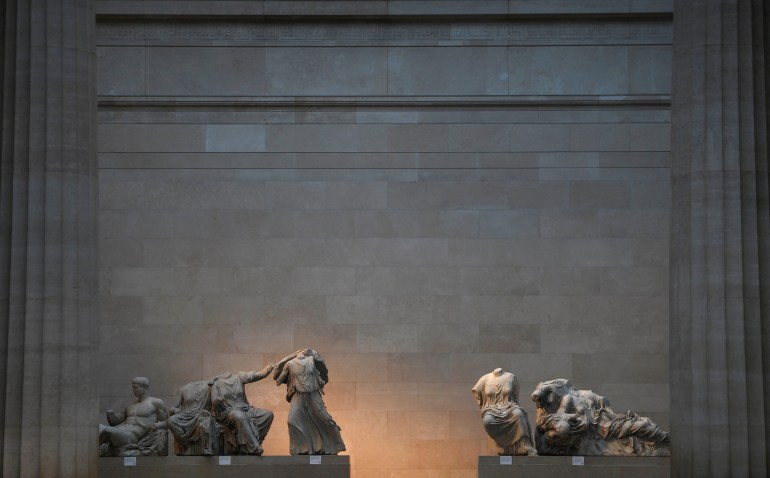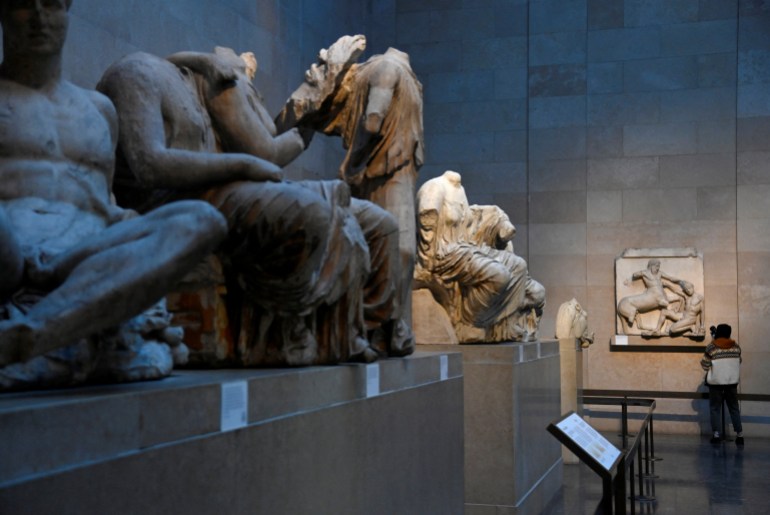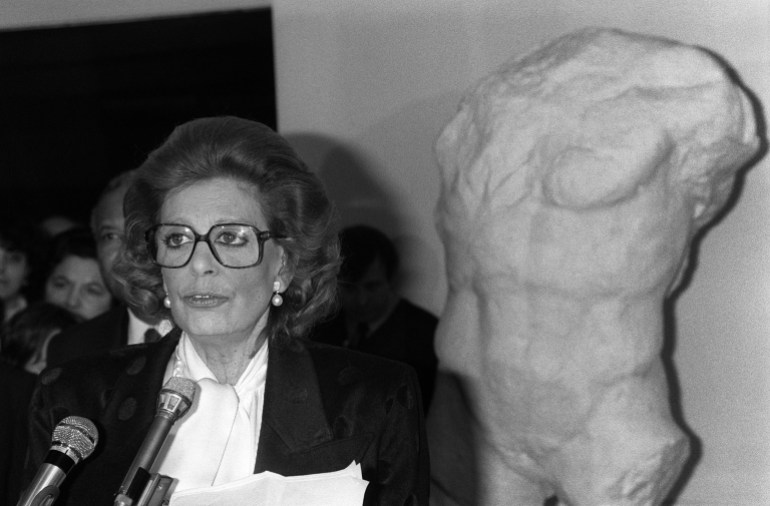How Parthenon sculptures sparked a diplomatic row between Greece and UK | News
The UK prime minister cancelled a scheduled meeting with his Greek counterpart after Athens demanded permanent return of ancient sculptures.
Britain’s Prime Minister Rishi Sunak has cancelled a planned meeting with his Greek counterpart Kyriakos Mitsotakis, sparking a diplomatic row over the status of the 2,500-year-old Parthenon sculptures housed in the British Museum.
Greece has repeatedly asked for their permanent return to Athens, while the United Kingdom and the museum have refused to do so.
Here is what we know about the ongoing dispute that has triggered a social media storm in Greece:
What was the UK-Greece dispute about this time?
- According to reports, the decision to cancel the UK prime minister’s meeting came after Mitsotakis told British broadcaster BBC that the Parthenon sculptures had been stolen and should be returned.
- “If I told you that you would cut the Mona Lisa in half, and you will have half of it at the Louvre and half of it at the British Museum, do you think your viewers would appreciate the beauty of the painting?” Mitsotakis said in the interview.
- The Greek government was told about the cancellation of the meeting at about 18:00 GMT, when Mitsotakis’s meeting with Keir Starmer, leader of the opposition Labour Party, was ending, according to a report by Bloomberg.
- In a statement, Mitsotakis said he was dismayed that the meeting was cancelled. “Greece’s positions on the issue of the Parthenon Sculptures are well known,” he said in a release.
- “I was hoping to have the opportunity to discuss them with my British counterpart as well, along with the major challenges of the international situation: Gaza, Ukraine, Climate crisis, migration,” the release added.
- On Wednesday Mitsotakis also said this will not necessarily affect the relationship in the long term. “It is a relationship with historical depth.”
What are the Parthenon sculptures in dispute?
- The Parthenon sculptures consist of more than 30 ancient stone sculptures from Greece dating back more than 2,000 years. They are held in the British Museum.
- They are original parts of the temple dedicated to the goddess Athena, in the iconic Parthenon, completed in 432 BC as the crowning glory of Athens’s Golden Age.
- London holds 17 pedimental figures and 15 panels.
- The panels show scenes from Greek mythology. One of those stretches for 75 metres (247 feet) and shows a procession for the birthday of the goddess Athena.
- All survived mostly intact despite war, earthquakes, foreign invasions and the temple’s makeover first as a church and then as a mosque under the Ottoman rulers. But in 1687, the Parthenon was blown up by a besieging Venetian army, and many of the works were lost.
- “Of the 50 percent of the original sculptures that survive, about half are in the British Museum and half in Athens,” according to information on the British Museum webpage.
- For decades, these were known as the Elgin Marbles, after the Scottish nobleman who took them more than 200 years ago. Now even the British Museum goes by the preferred Greek form – Parthenon sculptures.
Why are the Parthenon sculptures important?
- Ancient Greek sculpture has been admired for millennia, serving as a key artistic point of reference. For many, Parthenon sculptures are its most striking example.
- They form a coherent group designed and executed by top artists – the Leonardo da Vincis of the day – for a single building project meant to celebrate the height of Athenian glory.

How did they end up in the British Museum?
- More than a century after the destructive explosion, British ambassador to the Ottoman Empire – of which Athens was still a part – Lord Elgin obtained a permit to remove some of the sculptures.
- They were shipped to the UK and eventually joined the British Museum’s collection in 1816 – five years before the uprising that created an independent Greece.

What is Greece’s stance?
- Athens has called for the permanent return of the treasures since its independence from the Ottoman Empire in 1832. It has accused Elgin of theft.
- But the campaign became a major issue in 1983 when Greek Oscar-nominated actress Melina Mercouri, launched an official campaign for their return when she was culture minister during 1981-89.
- The UK was irritated with the campaign but “staff were worried that Mercouri was winning the debate”, declassified documents on the spat said.
- Mercouri argued that the Marbles “are an integral part of a monument that represents the national spirit of Greece”. The officials in the UK foreign office concluded that Mercouri “won the argument hands down”.
- In her first declaration to British authorities, she wrote: “You must understand what the Parthenon Marbles mean to us. They are our pride. They are our sacrifices. They are the essence of Greekness.”

- In September 2019, Mitsotakis suggested Athens would be willing to loan antiquities to the British Museum in return for being able to temporarily exhibit them. Greece said the proposal did not alter its longstanding demand for their permanent return.
- In December 2022, Greece said it was in talks with the UK over the repatriation of the sculptures to Athens but a deal was not imminent.
What’s the UK’s stance?
Check out our Latest News and Follow us at Facebook
Original Source






